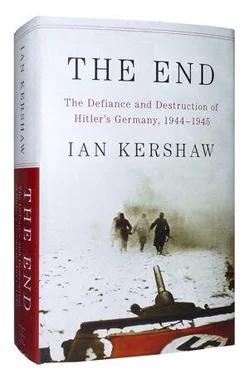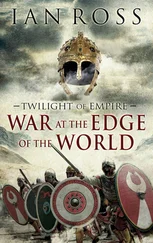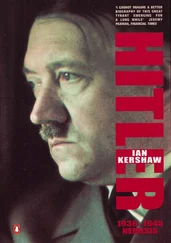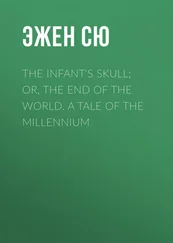prisoners of war 107, 109
Allied 160, 243; American 156; German murder of 156
Geneva Convention on 259
German, in Allied hands 32, 56, 70, 71, 154, 160, 196, 211, 226, 255, 260–61, 267–9, 270, 306, 315, 369; in Australia 306; in Soviet hands 94, 252, 368, 369, 371; from Army Group Centre 375; deaths among 375
in Germany 18, 83, 104, 125, 143, 237, 238, 254, 381–2
propaganda 7, 9–10, 20, 23, 24, 31, 61, 72, 105, 106, 121, 140, 142, 157, 159, 186, 187, 212, 242, 259, 279–80, 318, 345, 390
anti-American/British 238–9, 257, 279–80
anti-Bolshevik 98, 187, 195, 223–4, 313, 356, 394
anti-Jewish 123–4, 208
as counter-productive 115–17, 208, 209, 213, 222–3, 256–7
on Dresden bombing 238–9
Kolberg (propaganda film) 147–8, 250, 276
loyalty rallies 31
on Red Army atrocities 112–17, 118, 120
Special Action of the Party Chancellery speakers 256–8
in support of Nazi Party 258
verbal 222–3, 256–8
see also Soviet propaganda
Prussia see East Prussia
public opinion 18, 20, 99, 106–7
on von Stauffenberg assassination plot 31–3
see also Hitler, German allegiance to; morale
von Pückler-Burghaus, SS-Gruppenführer Carl Graf 370
racial enemies concept 9–10, 184, 208
‘inferiors’ 208, 226
see also Jews
Rahn, Rudolf (German ambassador to Italy) 364, 366
railways 22, 63, 64, 65, 66, 76, 102, 103, 135, 139, 151, 152, 173, 177–8, 184, 211, 213, 239, 275, 299
Allied bombing, effect on 79, 82, 136, 137, 140, 143
see also transport
Rastenburg see Wolf’s Lair
Ratibor 252
Ravensbrück concentration camp (for women) 330, 334, 336
raw materials, supplies of 80, 93, 94, 131, 244
distribution 135–6
see also coal supplies; iron/steel production
Red Army
American Army, meeting up with (April 1945) 339
in Austria 301, 316
Berlin, advance on 168, 173, 174, 175, 250, 253, 293, 294, 300–302, 308, 315–21, 324; encirclement of 337–47
in Bohemia (Czechoslovakia) 370, 373–4
drunkenness among 189
German civilians’ fear of 11, 12, 18, 91, 98–100, 105, 107, 108, 112–14, 117–18, 119, 120–22, 164–5, 177–84, 223–4, 270, 271, 273, 313, 324, 245, 349, 355, 356–8, 394, 395
German civilians, treatment of 176–86; labour camps, deportation to 181
Germany, offensive against (Summer 1944) 17, 24, 27, 28, 32, 33, 46, 49, 75, 92–6, 102
Germany, invasion of (October 1944–on) 17, 110–22, 123, 131, 132, 165–6, 167–206, 219, 247, 250–53, 259, 393–4; aims/objectives 168; Guderian on 110; maps of 175 , 248 , 249 ; troop numbers 168, 169; see also Berlin, advance on above
Hitler on 118
Hungary, invasion of (1944) 131, 132, 151, 170, 284, 316
looting by 357
Poland, advance into (1944) 15, 112, 167, 169, 171, 174, 176
Polish troops in 174
strategic planning 388
superiority of 168, 170–71
troop numbers 168, 169, 301
see also Soviet Union
Red Army atrocities 98, 180–81, 188, 357–8, 370, 394
at Nemmersdorf 110, 111, 112–14, 176, 394; Nazi propaganda based on 114–17, 120, 122
Hitler on 118
Jews, treatment of 394
Nazi propaganda on 112–17, 118, 120
Red Cross see German Red Cross; Swedish Red Cross
refugees see evacuation, of civilian population
Regensburg 342–3
Das Reich (newspaper) 239
Reich Chancellery 25, 38, 39, 40, 42, 162
Allied bombing (February 1945) 242
building 24, 295
Führer bunker see Hitler, Adolf, in Berlin
Reich Iron Federation 136
Reich Labour Service 71
Reich Press Office/News Agency 115
Reichsbahn 138, 140
see also transport
Reichsverteidigungskommissare (Reich Defence Commissars) (RVKs) 22, 41–2, 43, 52, 76, 88, 89, 101, 102, 103, 225–6, 290–91
Reinecke, General Hermann 46–7
as head of army NSFOs 68
Reinefarth, SS-Brigadeführer Heinz 251, 252
Reinhardt, Colonel-General Georg-Hans 33, 111, 114, 119
on eastern front 168, 171, 196–200, 202; dismissal (January 1945) 200, 202, 221, 310
Guderian and 197, 198, 199, 200, 205
Hitler and 196–8, 200; on his death 349
religion
Christian beliefs 72
Nazi Party attitude to 21
Nazi Party, Christian attitudes to 381
Remagen 254, 263, 278
Renduli´c, Colonel-General Lothar 202–3, 251, 263, 368
surrender 369, 370
Replacement Army 23, 25–6, 29–30, 35, 82, 84–5, 206
Himmler as C-in-C 35–8, 40, 353, 396
see also German Army
resistance movement, in Germany 149, 387
see also Stauffenberg, plot to assassinate Hitler
Rhine river
Allied crossing of 253, 254, 255, 256, 260, 266, 268–9, 270, 271, 281–2, 297
German defence 288–9
Rhine/Ruhr industrial area 58, 81, 131, 136, 138, 139, 141, 149, 150, 222, 254, 255, 262, 287, 328
Allied bombing 235
Red Army capture of 305
von Ribbentrop, Joachim 90, 163, 358
Allies, his attempts to negotiate with 280–81, 282–3, 291
as Foreign Minister 20, 150, 163
Goebbels on 243–4, 282
Dönitz as Reich President and 361–2
von Richthofen Lieutenant Freiherr 53
Riga, German retreat from (October 1944) 95
Ritter von Greim, Colonel-General Robert 205
Röchling, Hermann 136
Roer river 131
Rohland, Walther 136, 149, 290, 304
Rokossovsky, Marshal Konstantin 169, 173, 183, 301
Romania 62, 93–4, 100
Rome, fall of (1944) 17
Rooks, Major-General Lowell W. 378
Röttiger, Hans 366
Ruckdeschel, Ludwig 322, 323
as Gauleiter of Bayreuth 342–3
Rügen 179
Ruhr see Rhine/Ruhr industrial area
von Rundstedt, Field-Marshal Gerd 28, 32, 49, 59, 130
as C-in-C West 69, 70, 130, 132–3, 160, 170, 263; dismissal (March 1945) 254
Russia see Soviet Union
Russian Army see Red Army
Russian revolution 7
RVKs see Reichsverteidigungs-kommissare (Reich Defence Commissars)
Saar industrial area 58, 61, 65, 132, 136, 140, 141, 255
Sachsenhausen concentration camp 328, 330, 332, 333, 337
von Salisch, SS-Standardtenführer Carl 217
Sauckel, Fritz 83
Saur, Karl Otto 43, 83, 135, 137–8, 141, 160, 292, 346, 352
Saxony 125, 297
Scandinavia 256, 283, 361
see also Denmark; Finland; Sweden
Schellenberg, SS-Brigadeführer Walter 283, 284
Schepmann, Wilhelm (SA head) 85–6
von Schirach, Baldur
as Gauleiter of Vienna 317
as Hitler Youth Leader 118, 317
Schleswig-Holstein 361, 366–7
Schneidemühl 218–19
Schörner, Colonel-General (later Field-Marshal) Ferdinand 50, 51, 95, 221, 305, 395
on army deserters 219
as Army Group A (subsequently Army Group Centre) C-in-C 252, 301, 353, 368, 369–71; post-capitulation 373–5
as Army Group North C-in-C 94–5, 219, 259
brutality accusations against 374, 395
on disaffected army officers 221, 263
on Hitler’s suicide 348–9
imprisonment/trial in West Germany 203, 374
Soviet Union, captivity in 374
Schulz, General Friedrich 299, 305, 316
Schulze-Fielitz, Günther 137
Schutszstaffel (Protection Squad) see SS
Das Schwarze Korps (SS newspaper) 210
Schweinfurt ball bearing works 291
von Schweppenburg, General Geyr 28
von Schwerin, General Gerd Graf 63
Schwerin von Krosigk, Lutz Graf (Finance Minister) 241–2, 278, 360
Berlin, evacuation from 341
Читать дальше












